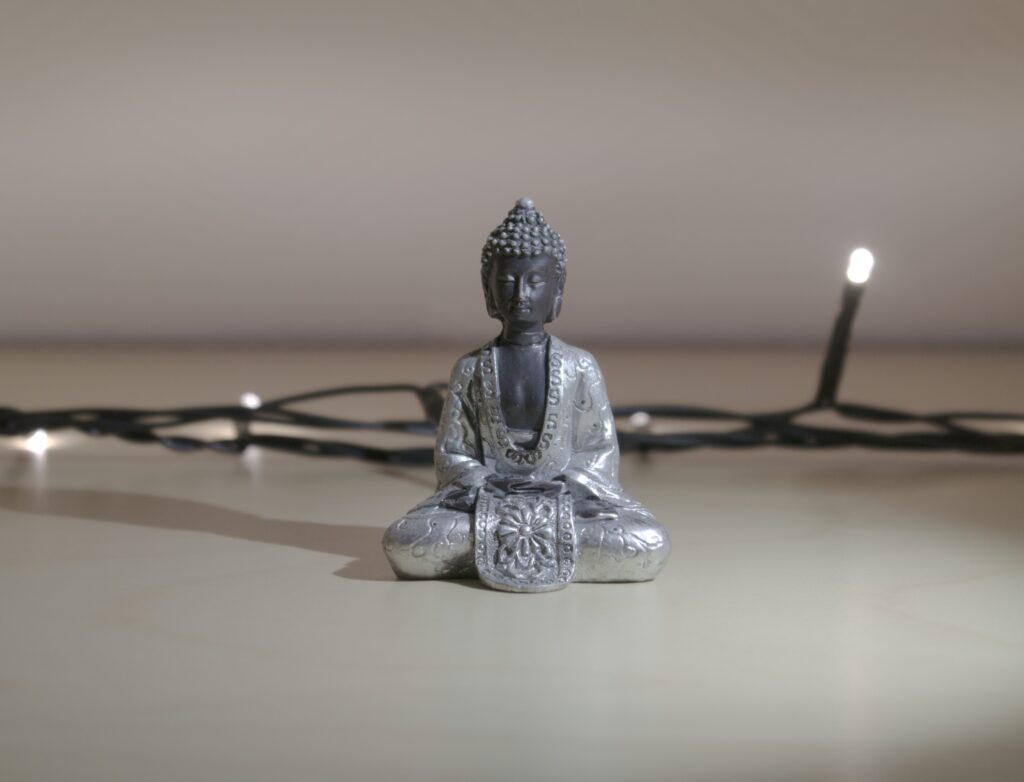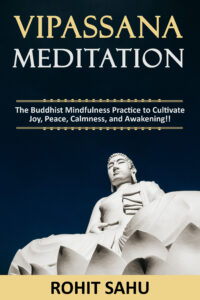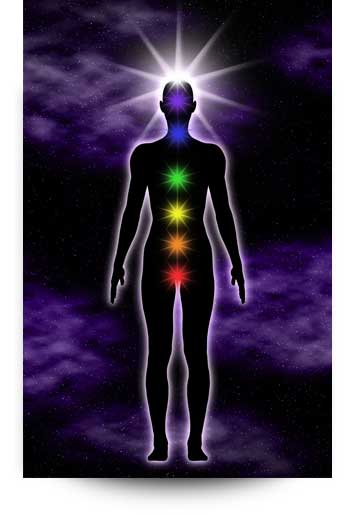We all face anger, frustration, and chaos from time to time. When we suffer, we do not keep our sorrow to ourselves; rather, we spread it to others as well. Thus, enlightened individuals have suggested ‘Know yourself,’ which means not only understanding oneself intellectually, or embracing yourself emotionally or devotionally, but experiencing the truth about yourself, within yourself, at the experiential level. To do this, Vipassana meditation practice was taught in India over 2500 years ago as a standard cure for universal issues.
Vipassana allows us to experience peace and harmony by cleansing the mind and liberating it from pain and the root causes of misery. The practice gradually leads to the ultimate spiritual goal of complete freedom from all mental defilements.
Purpose of Vipassana
The ever-changing universe of matter and life is known as the field of impermanence. The womb of pain is the bondage of attachment to this fleeting world. Vipassana is therefore an endeavor or a route for the journey from impermanence to permanence, for freedom from attachment to impermanence or suffering. Pain and pleasure are unavoidable by-products of the impermanent world. The fundamental cause of bondage and misery is to become the enjoyer of this agony and pleasure. Vipassana is a methodology, a way of meditation that transforms the enjoyer (Bhokta) into a seer (Drasta).
The act of seeing is the literary meaning of Vipassana. It means to perceive things as they are right now, to constantly be a seer in the current moment. Withdrawing from both the past and the future and being in the present frees the mind of memories, dreams, hopes, and aspirations. As a result, vision becomes clear and crisp, allowing you to perceive the truth. To be free of pain, one must first understand the nature of suffering. In Vipassana meditation, the door to acquiring a clear vision to find the truth is also opened.
Vipassana Benefits
1. Equanimity
The list of Vipassana Meditation benefits begins with equanimity. The primary aim of Vipassana Meditation is to achieve this. To be equanimous is to be calm in any circumstance. Whether the circumstances are favorable or unfavorable, they do not affect our minds; this is referred to as equanimity.
Throughout our lives, we encounter a variety of circumstances. Some of those circumstances are beneficial to us, while others are unfavorable. Every moment, our mind reacts to such circumstances. Vipassana alters our subconscious mind’s habit of responding to both positive and negative events at all times.
The Sankharas continue to accumulate and grow in our subconscious mind whenever our mind responds to such circumstances. As a result, our mind’s tendency to respond to both favorable and unfavorable circumstances grows. This harm both our minds and bodies.
By being calm, the Sankharas in our subconscious mind is eliminated when they manifest as sensations.
In the Bhagwat Geeta, such individuals are referred to as Stith Pragya (Chapter 5, Verse 3).
2. It is Free and Open to All
This technique of mediation is completely non-sectarian and is accessible to people of all religions, races, genders, and sexualities.
Its non-denominational set of principles is global and not affiliated with any dogmatic organization trying to convert or deceive you.
Vipassana meditation is completely free and easy to practice. As a result, the whole process is free of vested interests as well as hierarchical power and influence systems that may distort the teachings.
3. Calms the Mind
To achieve an elevated level of self-awareness, you must first learn how to calm the mind.
This does not occur during a single meditation, nor can it occur while you are immersed in the trappings of the world. As a result, Vipassana encourages daily focused practice, as well as long silent meditation retreats.
During the first few days of practice, you may notice that your mind goes into overdrive rather than settling down. This is a normal event, and it is just the process of being aware of the jumbled thoughts that are constantly there.
This rush of thought, however, should decrease as you continue your practice.
4. Enriches Mental Wellness
Vipassana’s stress-relieving benefits may enhance other elements of mental well-being.
It’s no surprise that centering your mind and not engaging with others causes the continuous stream of thoughts we encounter every second of every day to slow down.
As a result, you begin to have brief moments of sheer tranquility and peace.
This may be a liberating feeling, enabling you to reduce those negative thinking patterns, to-do lists, and needless worries that we all have.
Losing them, even for a short period, may provide you with a feeling of clarity that is much more useful in life than any mental checklist.
It’s also very satisfying and revitalizing.
In fact, it provides you with a whole new viewpoint on the operation of your mind and your behavioral habits.
A 2018 research of 520 people found that those who practiced Vipassana had greater levels of:
- Self-acceptance
- Competence
- Involvement and growth
- Positive connections
5. Enhances Physical Health
Many people concentrate on mental health when discussing the health advantages of meditation, ignoring the significant physical effects meditation may have on your body.
Vipassana practitioners are particularly adept at this since they are urged to alter their diet, eating a plant-based diet during the sessions and drastically decreasing the number of calories eaten in the evening.
New meditators are advised to snack lightly on fruit instead of eating supper, while veteran meditators are encouraged to avoid eating anything after noon.
A lighter diet is recommended even during the early meals. All of this leads to physical health benefits, ranging from weight loss to a reduction in chronic illnesses and the risk of heart disease.
Vipassana has also helped many individuals eliminate harmful urges and addictions, including alcohol and smoking addictions.
6. Cultivate Inner Peace and Calmness
The capacity to develop a sense of inner peace is one of the most major benefits of Vipassana. This serenity lies at the heart of your being, and the act of quieting the mind and disconnecting from the world around you brings you closer to it.
This is because, as your mind moves away from the ego’s incessant demands, it sees the universe through open eyes, experiencing profound appreciation and love for everything that is.
Without your own restraints and preoccupations, you may notice a continuous flow of peace all around you.
The new perspective it has provided on my life has permeated my everyday reality. This has become truer for me now that I have included a regular meditation practice into my morning routine.
It may entail getting up a little earlier, but it’s worth it for the way it roots me throughout the day and helps me weather life’s storms with more mental fortitude.
7. It Teaches Us to Make Sacrifices
It allows the mind to sacrifice much more for the greater benefit of everyone, working without weariness, happy to work, just the reverse of what it was before practicing meditation.
8. It Satisfies Our Complete Happiness Quota
It allows one to obtain the seven types of happiness—human happiness, divine happiness, meditative happiness from insight, happiness from the noble path, happiness from the fruit of the path, and happiness from Nirvana, according to one’s own practice or according to one’s own particular character and level of excellence.
9. Provides Addiction Recovery
The list of Vipassana Meditation benefits would be incomplete without it. This is one of the most significant advantages of Vipassana Meditation.
Addiction does not just refer to the use of alcoholic beverages, smoking, drug use, and tobacco use. What Exactly Is Addiction? Consuming something again and over, despite the negative effects. Performing any task regardless of the repercussions.
We’ve become so used to that activity that if we don’t do it, we feel restless and furious on the inside. Mobile, Social Media, Mobile or Computer Games, Tasty and Unhealthy Food, and so forth.
Some addictions are beneficial, too:
- Humanitarian service.
- Do more for others than you do for yourself.
- Compassion
- Mercy
- Non-Violence
By maintaining the mind equanimous, Vipassana reduces harmful addictions on the level of our subconscious mind. It feeds the addictions to mercy and compassion.
An earlier 2006 research discovered that Vipassana meditation may help with drug addiction. The researchers speculated that the technique might be used in place of traditional addiction therapies.
Mindfulness training, such as Vipassana, may assist by substituting cognitive suppression, according to a 2018 review. Thought suppression may boost urges and make self-control harder.
Meditation may also help to reduce stress, which has been related to drug abuse. More study is required, however, to understand how Vipassana may help with addiction management.
10. It Boosts Your Self-Esteem and Confidence in Your Abilities
Doing something that terrifies or challenges us is often beneficial to our growth. Discomfort does not always have to be avoided, particularly if it is experienced healthily and mindfully.
It may seem like sitting through hours of stillness is an overwhelming feat. However, when you surprise yourself by doing so, your feeling of accomplishment will demonstrate how competent you really are. I can’t tell you how many individuals I see with big grins of pleasure on their faces at the end of 10-20 days of Vipassana meditation.
Challenging yourself may significantly improve your self-esteem and self-confidence; you push your limits, put your perseverance to the test, and emerge shining with the knowledge that you endured something tough and uncomfortable.
11. Encourages Sound Sleep
That is true! One of the advantages of Vipassana Meditation is that it improves the quality of our sleep. When we practice Vipassana before going to bed regularly, the quality of our sleep improves dramatically.
It is the quality of sleep that is important, not the amount. We feel rejuvenated after waking up if we sleep for 3-4 hours after practicing Vipassana. Even after 8-10 hours of sleep, such a level of freshness is not achievable.
There is a scientific explanation behind this. Vipassana, like any other spiritual method, is based on science. Spirituality is the study of the mind and body. Vipassana teaches us to be calm. When our mind is calm, it has an instant impact on our physical and psychological structure. When we sleep peacefully, we wake up feeling rejuvenated.
12. The Path Leads to Nirvana
Every spiritual path’s ultimate and only aim is to achieve Nirvana. This is the most obvious of the many advantages of Vipassana Meditation.
Nirvana is the Sanskrit word for enlightenment. Nirvana is the realization of the truth of our existence. There is nothing more to learn about anything after Nirvana. The individual becomes more grounded. This is an ecstatic state. The individual knows he is a part of the Supreme Reality. This is a very rare condition.
When a person achieves advanced levels while practicing Vipassana and also passes those advanced stages, he or she enters the state of Nirvana.
The Practice Overview
Vipassana meditation practice entails adhering to the principles of Dhamma/Dharma, the universal rule of nature. It entails following the noble eightfold path, which is generally divided into Sila (Morality), Samadhi (concentration), and Panna (wisdom, insight).
It is truly useful only if it results in a change in your life, and that change will only occur if you continue to practice the method regularly.
This is practiced in everyday life through adhering to the 5 Precepts:
- To not kill any living creature,
- To avoid stealing,
- To avoid sexual impropriety,
- To avoid making rude remarks,
- To refrain from all intoxicants.
Vipassana is not to be confused with mindfulness meditation, which focuses on awareness, or transcendental meditation, which employs a mantra. Instead, it imposes a blanket command of non-response. To gain insight into the true nature of this reality, Vipassana meditation employs Sati (mindfulness) and Samatha (calm), gained via techniques such as Anapanasati (mindfulness of breathing), in conjunction with the study of impermanence as seen in physical and mental changes.
Regardless of the agony you’re experiencing while you sit, or the fact that your hands and legs are falling asleep and your brain is begging for relief. You are told to concentrate your attention on the objective sensations in your body, rising and falling, while you do a particular order scan of your limbs. Over 10-15 days of precise practice, you stop responding to the ups and downs of life.
Practice begins with the preparatory stage, the practice of Sila, morality, giving up worldly thoughts and desires.
The practitioner next participates in Anapanasati, or breathing awareness, which is described in the Satipatthana Sutta as walking into the forest, sitting under a tree, and then just watching the breath. If the breath is lengthy, note that it is long; if the breath is short, notice that it is short.
The meditator becomes aware of how sense impressions emerge through the interaction between the senses and physical and mental events by observing the origination of physical and mental phenomena, as stated in the 5 Skandhas and Paticcasamuppada.
The practitioner also realizes the ever-changing nature of breathing, as well as the coming and passing away of awareness. This observation is followed by thoughts on causes and other Buddhist teachings, which leads to the understanding of Dukkha (sorrow), Anatta (non-self), and Anicca (impermanence). When the three qualities are grasped, reflection becomes subdued, and the process of observing speeds, observing things in general but not necessarily identifying them.
Jhana Stages in the Vipassana Ideology:
The meditator initially investigates the body/mind link as a single entity, nonduality, and discovers three qualities.
- Being in the presence of Vitarka (applied attention) and Vicara (thought) constitute the first Jhana. Phenomena manifest as appearing and disappearing.
- The practice seems easy in the second Jhana. Vitarka and Vichara both vanish.
- Piti, or joy, vanishes in the third Jhana, leaving just pleasure (Sukha) and focus.
- The fourth Jhana emerges, characterized by serenity and purity of awareness. Direct knowledge is gained during the journey. Because the disintegration of all things is plainly apparent, the comfort fades. Every event will be shown as unstable, transitory, and disenchanting as a result of the practice. There will be longing for freedom.
This whole practice is a mental training. Vipassana may be utilized to build a healthy mind in the same way that we use physical exercises to enhance our physical health.
Because it has been shown to be really beneficial, great emphasis is being placed on maintaining the method in its original, purest sense.
The more the method is used, the more freedom from suffering there is, and the closer one gets to the ultimate objective of complete liberation. Even 10 days may provide effects that are apparent and clearly helpful in daily life.
Want to Learn More about Vipassana Meditation, Check This Out-
This step-by-step Vipassana guide takes the reader through practices that may open new levels of awareness and understanding. This book’s aim is to teach you how to live consciously so that you may ultimately be calm and joyful every day of your life!
This is an authentic and practical guide to Samatha, materialism, mind, dependent origination, and Vipassana based on the Buddha’s teachings. This book will walk you through the stages and methods of overcoming stress, sadness, fear, and anxiety through the practice of Vipassana meditation.
It will explain what this method is and how it came to be. This book also demonstrates how to utilize Vipassana meditation to make our everyday lives more meaningful and, ultimately, to discover the real meaning of peace and tranquillity.
In this book, you’ll discover:
✔️History of Vipassana Meditation
✔️The Deeper Realm of Vipassana
✔️The Purpose of Vipassana
✔️The Benefits of Vipassana Meditation
✔️The Right Attitude Towards the Practice
✔️How to Create a Vipassana Retreat at Home
✔️The Step-By-Step Vipassana Meditation Practice
✔️Tips to Boost Your Progress
✔️Additions to Catalyze Your Vipassana Session
✔️Beginners Mistakes
✔️Common Myths and FAQs
✔️Some Pointers from My Experience
Following the instructions in this book will teach you how to develop profound stability, maintain an in-depth study of the intricacies of mind and matter, and ultimately unravel deeply conditioned patterns that perpetuate suffering. It acknowledges with a detailed examination of the different insight and spiritual fruits that the practice offers, Nirvana/Enlightenment being the end goal.
Now don’t bother, claim your copy right away to welcome the serine influence of Vipassana Meditation in your bodily paradise!!






After all, what a nice web site and informative posts, I will add backlink bookmark this web site?